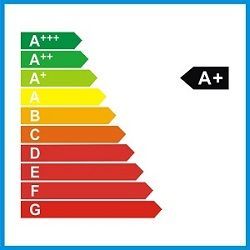 The freezer is a household appliance that allows you to store food at low temperatures for a long time. If you are not comfortable with the size of a standard refrigerator freezer, the solution in this case may be to purchase a separate freezer cabinet.
The freezer is a household appliance that allows you to store food at low temperatures for a long time. If you are not comfortable with the size of a standard refrigerator freezer, the solution in this case may be to purchase a separate freezer cabinet.
This equipment has several important parameters to consider when choosing. specific model: dimensions and volume, class of freezing, power, climate class, the presence of various functions, etc.
This article will discuss such an important parameter as energy efficiency. Of course, it must be taken into account when choosing any electrical device, but in the case of a freezer, the energy efficiency class is especially important for two reasons:
- firstly, the refrigerator is a powerful device that consumes a large amount of energy;
- secondly, it is characterized by the fact that it is constantly in the on state, which means that it continuously consumes energy.
What kind of energy class freezer is better to choose
The content of the article
-
What kind of energy class freezer is better to choose
- Class A +++
- Class A ++
- Class A +
- Class A
- Class B
- Classes C - G
 It is no secret that all over the world electric energy is an exhaustible, limited and rather expensive resource that people try to save at the state and household level. In this regard, manufacturers of electrical appliances are trying to use such circuitry solutions that can make their products the most energy efficient. But how to measure this parameter?
It is no secret that all over the world electric energy is an exhaustible, limited and rather expensive resource that people try to save at the state and household level. In this regard, manufacturers of electrical appliances are trying to use such circuitry solutions that can make their products the most energy efficient. But how to measure this parameter?
In European countries, at the beginning of the zero, they came up with a system of energy efficiency classes for devices. Since the beginning of 2011, by Government Decision No. 1222 of December 31, 2009, a similar system for certain types of electrical products was introduced in the Russian Federation.
Initially, 7 energy efficiency classes of devices were identified, which were denoted in capital Latin letters from A to G. For clarity, each letter was assigned a color in a gradient from green (highest grade) to red (worst performance). In this case, a conditional level was determined, corresponding to the average value of the energy consumption of devices of a certain group.
IMPORTANT! Each product group has its own index of energy efficiency classes.
Since manufacturers are constantly working to improve the operational performance of their products, category A was supplemented by three more subcategories. Thus, an exhaustive list is as follows:
- A +++;
- A ++;
- A +;

- BUT;
- B;
- C;
- D;
- E;
- F.
The class is determined by the energy efficiency index, which shows the ratio of the actual energy consumption of a particular device to the nominal (average values).
Class A +++
A +++ is today an indicator of the most energy-efficient technology. Such an indicator is infused with a small number of expensive modern models of refrigerators and freezers. For such a technique, the efficiency index is less than 22. This means that they consume less than 22% of electricity than an abstract device with average energy efficiency. Turning to the practical plane, we can say that the A +++ class freezer will consume about 5 times less energy. If you multiply this coefficient by power consumption, the cost of 1 kW, and the number of hours of operation per year, get an amount that means how much such a miracle device will save you a month on just one power consumption.
Class A ++
It corresponds to an index in the range from 22 to 33. Freezers with this index also belong to highly efficient devices with a consumption of less than 0.15 kWh / kg. Such equipment will be somewhat cheaper and more available on the market.
Class A +
These freezers consume only 32–42% of the conventional average model, which is also very good. Their consumption will be only 0.17-0.15 kWh per kilogram of frozen contents. Acquiring such a technique is also advisable if it satisfies all other parameters important to you.
The first three classes are in the zone of high energy efficiency and are marked in green.
Class A
To devices of this class there corresponds an index 42–55. Some 10-15 years ago, these devices would be considered the most energy efficient, but now they can soon be attributed to the economy class. You can purchase them because of the significantly lower cost for irregular use, for example, to the cottage for short-term inclusion or seasonal operation.
Class B
To date, this category contains the most low-efficient devices with an index of 55 to 75. The purchase of such equipment is hardly advisable.
Classes C - G
Such freezers can already be found infrequently from suppliers and manufacturers of household appliances. Below is a table with an energy efficiency indicator for each of the remaining classes.
| Class | Index | Consumption kW / h / kg |
| C | 75–95 | 0,23-0,27 |
| D | 95–110 | 0,27-0,31 |
| E | 110–125 | 0,31-0,35 |
| F | 125–150 | 0,35-0,39 |
| G | >150 | >0,39 |


